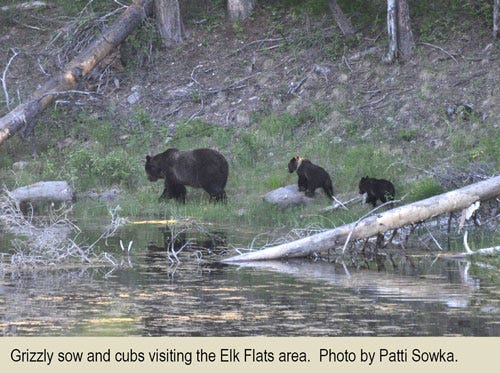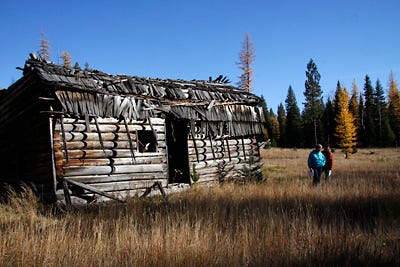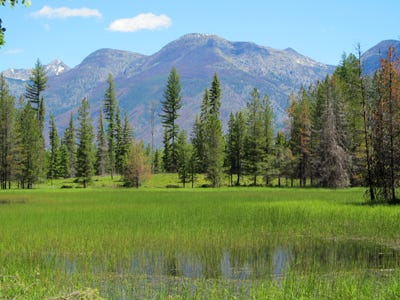Vital Ground Safeguards More Habitat for Grizzlies & Other Wildlife in Western Montana
The Land Trust Protecting Iconic North American Species Through Land Consevation
By Jordan Schaul | National Geographic | December 27, 2013
Dr. Jordan Schaul provides some recent news regarding Vital Ground’s continued efforts to protect wildlife habitats in Montana. Recognized as a formidable apex predator, we sometimes forget that the iconic grizzly bear is part of an impressive faunal assemblage where it occurs in the western states. From large deer species to mesopredators, quality habitats for grizzlies can be used by many of North America’s most popular and majestic wild animals.
Dr. Jordan Schaul provides some recent news regarding Vital Ground’s continued efforts to protect wildlife habitat in Montana.
Recognized as a formidable apex predator, we sometimes forget that the iconic grizzly bear is part of an impressive faunal assemblage where it occurs in the western states. From large deer species to mesopredators, quality habitat for grizzlies can be used by many of North America’s most popular and majestic wild animals.
The brown bear is not just the top consumer in the food chain or what ecologists would consider a ranking member of the highest trophic level in a given food web. Rather, the grizzly is one of many integral species in its respective ecosystem in terms of the services it provides. Healthy grizzly habitat is comprised of many other charismatic species, both terrestrial and aquatic. All provide an important ecological function.
The Montana-based land trust Vital Ground knows this and although they are dedicated to conserving habitat for grizzlies they are most aware of their potential to help conserve an array of other North American wildlife species. Several of these animal species serve as food resources for the iconic bears. Others are tied to the grizzly bear more indirectly.
The grizzly bear may be at the top of the food chain, but another way we consider its ecological role is that it serves as an umbrella species. In other words, activities that influence the fate of the grizzly also impact a number of other species that utilize the brown bear’s habitat. Hence, conservation practitioners and other environmental policy makers often make management decisions in collaboration with government officials and private landowners that are intended to influence an entire group of species that service a given ecosystem. For example, decisions that influence the grizzly bear in Montana also typically have an impact on whitetail and mule deer (blacktail deer), elk, moose, mountain lion, songbirds, and a host of sensitive wildlife species native to the area.
This past month, Vital Ground, with the help of several landowners, successfully afforded protection for 300 acres of wildlife habitat in northwestern Montana’s Swan Valley through the Elk Flats Neighbors Project (EFNP) in Condon. Condon is about an hours drive from Glacier National Park.
According to a Vital Ground spokesperson, “through a combination of five permanent conservation easements and one fee-title acquisition, six properties west of Condon, Montana will forever benefit grizzly bears, whitetail and mule deer, elk, moose, mountain lion, songbirds and sensitive fish and wildlife species.”
Condon sits between the Swan Mountain Range and the Mission Mountains, which boast summits reaching elevations of over 9,000 feet. The region draws many retirees and celebrities eager to find seasonal homes and permanent residences next to nature at its finest and most pristine in the lower 48.
As a conservation tool, conservation easements essentially prohibit or constrain certain activities by the landowner that are inconsistent with conservation objectives of the land trust or other entity. However, with the negotiation of a conservation easement the land remains property of the granting landowner. Besides the inherent benefit of affording protection to the natural heritage of the region, the landowners may receive state or federal tax advantages by negotiating such conservation objectives.
While protecting habitat for terrestrial wildlife, including grizzly bears, the safeguarding of privately owned land in Swan Valley will also help protect riparian habitat located in the region, which serves as drainage basin for the Swan River and its tributaries like Cold Creek. At least two conservation sensitive salmonids can be found in Cold Creek.
“Cold Creek is designated critical habitat for bull trout and these properties directly contribute to both water quality and quantity in the watershed, as well as provide habitat for myriad wildlife species ranging from grizzly bears and Canada lynx to waterfowl and amphibians,” said Ryan Lutey, Vital Ground’s Director of Lands.
The effort to secure a future for bears and other species in the region is a culmination of discussions and cultivated relationships built around a common vision for Swan Valley. “We are continuing the concept of maintaining vital wildlife habitat as well as productive private forests,” says Bill Moore, one of the participating landowners. “We are ‘listening to the land’ and striking a sustainable balance in our part of the [region].”
Since Vital Ground’s first conservation easement in the area, significant conservation investments there have also been made by organizations and agencies including The Nature Conservancy of Montana, Swan Ecosystem Center, Confederated Salish and Kootenai Tribes, U.S. Forest Service and Bonneville Power Administration.
In conjunction with the other public and private conservation holdings in the area, this effort will help bridge the valley floor between the Bob Marshall Wilderness and the Mission Mountains Wilderness. In addition to generous donations of the landowners and many individual donors, the Elk Flats Neighbors Project is also supported by the Charlotte Y. Martin Foundation, Cinnabar Foundation, Cutler Foundation, Metabolic Studio, Missoula Open Space Bond Fund, Montana Coffee Traders, Oberweiler Foundation, Travelers for Open Lands and the William H. Donner Foundation.
ABOUT NATIONAL GEOGRAPHIC SOCIETY
The National Geographic Society is a global nonprofit organization that uses the power of science, exploration, education and storytelling to illuminate and protect the wonder of our world. Since 1888, National Geographic has pushed the boundaries of exploration, investing in bold people and transformative ideas, providing more than 14,000 grants for work across all seven continents, reaching 3 million students each year through education offerings, and engaging audiences around the globe through signature experiences, stories and content. To learn more, visit www.nationalgeographic.org or follow us on Instagram, Twitter and Facebook.
MEET THE AUTHOR
Jordan Carlton Schaul With training in wildlife ecology, conservation medicine and comparative psychology, Dr. Schaul's contributions to Nat Geo Voices have covered a range of environmental and social topics. He draws particular attention to the plight of imperiled species highlighting issues at the juncture or nexus of sorta situ wildlife conservation and applied animal welfare. Sorta situ conservation practices are comprised of scientific management and stewardship of animal populations ex situ (in captivity / 'in human care') and in situ (free-ranging / 'in nature'). He also has a background in behavior management and training of companion animals and captive wildlife, as well as conservation marketing and digital publicity. Jordan has shared interviews with colleagues and public figures, as well as editorial news content. In addition, he has posted narratives describing his own work, which include the following examples: • Restoration of wood bison to the Interior of Alaska while (While Animal Curator at Alaska Wildlife Conservation Center and courtesy professor at the University of Alaska) • Rehabilitation of orphaned sloth bears exploited for tourists in South Asia (While executive consultant 'in-residence' at the Agra Bear Rescue Center managed by Wildlife SOS) • Censusing small wild cat (e.g. ocelot and margay) populations in the montane cloud forests of Costa Rica for popular publications with 'The Cat Whisperer' Mieshelle Nagelschneider • Evaluating the impact of ecotourism on marine mammal population stability and welfare off the coast of Mexico's Sea of Cortez (With Boston University's marine science program) Jordan was a director on boards of non-profit wildlife conservation organizations serving nations in Africa, North and South America and Southeast Asia. He is also a consultant to a human-wildlife conflict mitigation organization in the Pacific Northwest. Following animal curatorships in Alaska and California, he served as a charter board member of a zoo advocacy and outreach organization and later as its executive director. Jordan was a member of the Communication and Education Commission of the International Union for the Conservation of Nature (CEC-IUCN) and the Bear Specialist Group of the IUCN Species Survival Commission (BSG-SSC-IUCN). He has served on the advisory council of the National Wildlife Humane Society and in service to the Bear Taxon Advisory Group of the Association of Zoos and Aquariums (AZA Bear TAG). In addition, he was an ex officio member of council of the International Association for Bear Research and Management.





